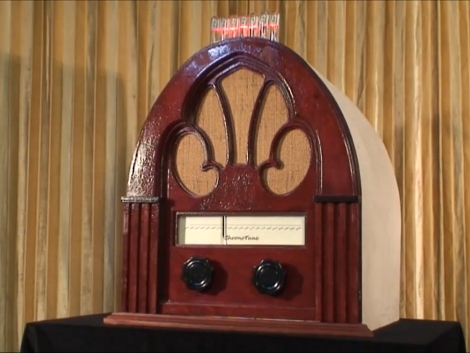
The ChronoTune is a radio that plays sounds from different eras. This project was developed as an entry for the Redbull Creation Challenge by some members of i3Detroit, a hackerspace in the motor city. It allows a user to turn the dial to tune in a new moment in history, but they can also listen in on the present day. They’ll be greeted with the sounds of a tuning radio, followed by music or audio clips common to the period displayed on the dial.
As you know from the last contest entry, each project must use an Arduino to qualify. It reads a rotary encoder attached to one of the knobs on the front of the case. This doesn’t directly move the tuning needle. Instead, it’s attached to the guts of an inkjet printer to move it back and forth. This lets the radio tune itself if need be.
The audio is played from several sources. There is an MP3 module that allows for longer clips, but there are also some ISD voice recorder chip modules that play back shorter clips. If the dial is tuned to present day, an FM radio module tunes in a station over the air.
Having trouble reading that dial? Don’t worry, there’s a simulated Nixie tube display sticking out the top of the case to provide a digital readout of the currently selected time period. Check out the video after the break to see the team walk us through each part of the ChronoTune.
[youtube=http://www.youtube.com/user/i3Detroit#p/u/2/udy-7MA6aWw&w=470]
[Thanks Duncan]















typo in title – “Chono” ?
what video? as of 0547PDT there is none
Someone dedicated enough could record their favorite radio station 24/7 and achieve something like this. I have some 3 hour blocks of one of my local stations recorded for the purpose of nostalgia one day. I was recording that from their online stream but it’s been less than reliable. I really ought to set up some sort of dedicated receiver, especially since they are only a couple miles from here. For size sake I really wish I could do song id on those recordings and remove a lot of redundancy, replacing multiple copies in each recording with a link to just one clip of each song. Maybe something like that could extract redundant content and build a m3u with the unique clips split up with redundant clips in between. Hmm.
Haha, first thing I saw was the typo in the title too. Interesting concept nonetheless. It actually makes a lot of sense to make a player like this. Sometimes you’re in the mood to hear some oldies.
What a neat idea! I’d like to see this tied to a large music library, where tuning the radio generates a playlist based on the year.
Intresting, I had a similar idea except with for TV programs,
kind of a generative playlist for your media player, ie you select “1960’s television”
and you get a constant playlist of 60’s TV shows and news-clips, with period adverts in between.
Maybe could use archive.org’s video collection for the source of all the content.
How does it handle new artists covering old songs? Or a version of an old song performed recently by the original artists who are still alive and touring? Can it run angrybirds?
How far back? The last 35 years are blank. Hopefully it goes back to the beginning of recorded music.
I tell many kids dissatisfied with music from the time they have to live in, how to navigate such a device. Start with The Decade (’65-’75)! Set your browsing by year, yes there are exceptions. Forget song titles! The next time focus, (’20-’35) hot not sweet of course!
Very cool and fun idea!
A SIMULATED Nixie tube display? Real Nixie tubes are available, and they’re not THAT expensive.
Speaking of radio nostalgia, I’m looking for a playlist of any info for WPLO-FM, about 1966 to 1975. This was “Underground FM” in Atlanta, it was comparable to the college stations as being an alternative to top-40 stations.
Oh, and that radio’s audio section should have a two-stage vacuum tube audio section, transformer output, class A all the way – 12AV6 and looks like there was a 12C5 version of the 50C5. THAT is how I listened to the radio back then.
Other than that, good hack. :-)
I built something very similar one year ago. a radio that works like a time machine. it doesn’t play music, but news. at first it loads the most recent news. when you choose a topic you can scroll with the tuning wheel in the past an get older articles matching to this topic. watch the video: http://www.youtube.com/watch?v=sst8vwcz7fg